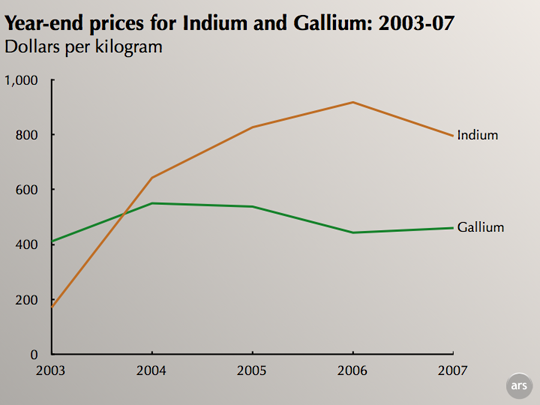Will we run out of some of the basic elements fundamental to modern technology? This is a question that has recently lit up the blogosphere. In particular, the elements Indium and Gallium are frequently referred to as "threatened." The herd latched on to an eloquent post on Asimov's Science Fiction, which was itself a rehashing of a New Scientist piece, which took its cue in part from an article in the Proceedings of the National Academy of Science (which, oddly enough, does not discuss either Indium or Gallium).
Regardless of the convoluted history, is there anything to really worry about here? Comments on blogs range from the insanely optimistic, "the invisible hand/technology will solve everything" perspective to things along the lines of "you idiots, the world is obviously doomed." Ultimately, there is a shred of truth to all of these, but let's look at a few key facts.
One of the arguments trotted out in most posts focuses on the fact that the price of Indium has risen from around $95 in 2002 to over $1000 in 2006. What these posts fail to point out is that it was around $180 in 2000, so $95 appears to have been carefully chosen as a starting point. The end point is pretty suspicious as well, given that Indium's price was around $665 in May. Meanwhile, everyone fails to point out that the price of Gallium has remained flat in recent years. Nevertheless, a three-and-a-half-fold increase over eight years is impressive, so, it's worth looking into where it came from.

Data source: USGS
The increase in the price of Indium most likely stems from a strong increase in demand. Indium is used in LCD monitors, and LCD sales took off over this same time period. Today, LCD panels represent over 50 percent of the market for Indium. Given that Indium represents less than three dollars of the cost of a large LCD panel, the demand side of the market is probably relatively insensitive to these increases in the cost of Indium.
To understand why the supply side has not increased production substantially with this increase in price, you have to look at how Indium is produced. Indium is extracted from raw materials mainly as a by-product of Zinc production. Because the price of Zinc has not increased recently, and may decrease in the near future, producers have little incentive to increase output.
Is the increase in price for Indium representative of its scarcity? Yes. Does this increase mean we are about to run out of Indium? No.
That is not to say that the supply of Indium, Gallium, and other materials are limitless. We will ultimately run out of the raw materials that we are producing them from, but that may not mean as much as it appears to. How much can we recover from recycling? Currently, over half of the world's supply (PDF) of Indium actually comes from recycling, and an entire company, Recapture Metals in Utah, is dedicated to Gallium recycling.
Furthermore, how reliant are we on these particular metals? Certainly, they are being used because of their unique chemical properties, but it's possible that we can find replacements or change our technology altogether. As one poster put it "We are, after all, nearly out of whale oil, yet we don't lack for indoor lighting." I want my 50-inch OLED and my silicon lasers!
Of course, that is not to say that we can replace any material we want. Take the use of lead in piezoelectric devices—we have banned lead in many materials, spent millions of dollars on research, and yet we still do not have a viable replacement for it. Ultimately we need to be aware of our use of resources, but the present overreaction is not all that well-thought-out.
reader comments